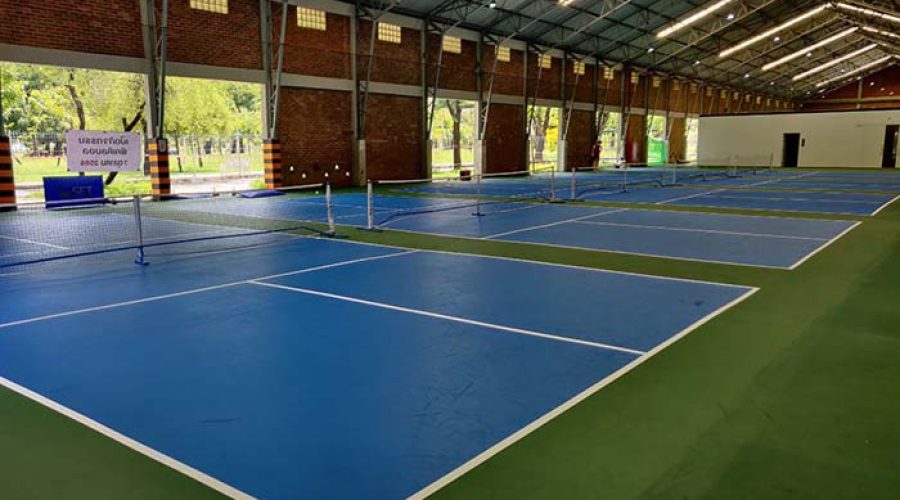Pickleball Court Size: A Complete Guide to Dimensions and Measurements
Jumping into the pickleball wave or already a fan looking to craft your own court? Getting the size right is key. A mismatch in dimensions could mix up your game and cause a bit of a pickle.
Every square inch matters in pickleball, just like every single point you score.
Here’s a cool fact: A pickleball court matches the size of a doubles badminton court. Got one of those? You’re halfway to a pickleball game! We’ll walk you through from the size needed, indoor or outdoor, to drawing those crucial lines.
Measuring and setting up will be a breeze with our guide. You’ll be all set for some epic game time on your court in no time.
Ready to dive in? By the end of this, you’ll have all you need to whip up some great fun on your court!
Key Takeaways
- The standard dimensions of a pickleball court for both singles and doubles play are 20 feet wide and 44 feet long, making it about one-fourth the size of a tennis court.
- Setting up a pickleball court involves marking specific boundary lines to outline the playing area, including sidelines, baselines, and the non-volley zone.
- Necessary materials for setting up a pickleball court include measuring tapes, boundary markers, net posts, nets, paint or tape for marking the surface accurately.
- When setting up an indoor pickleball court, consider ceiling height requirements for safe play; outdoor courts need weather-resistant materials to withstand environmental conditions.
Pickleball Court Dimensions
The pickleball court dimensions are specifically set at 20 feet wide and 44 feet long for both singles and doubles play. This means that the overall size of a standard pickleball court is about one-fourth the size of a tennis court, making it ideal for players of all ages and skill levels.
Size
Your pickleball court is this cozy little spot that’s 20 feet wide and 44 feet long. That’s pretty much a carbon copy of a doubles badminton court, making it a breeze to fit in most places where you can swing a paddle.
If you’re thinking in meters, that’s a neat 6.10m by 13.41m area. Perfect for squeezing into gyms or outdoor spaces. Planning a match or even a full-blown tournament? Just make sure you’ve got at least a 9m x 18m space. This gives everyone enough room to play safely and chase after those wild shots.
Yet, pickleball has a unique twist when it comes to space requirements. The total playing surface should ideally be 30 feet by 60 feet at the minimum, with a preferred size for tournament play of 34 feet by 64 feet. These dimensions ensure players have enough room to chase down every ball, making each game more dynamic and exciting.
Comparative dimensions (to badminton and tennis courts)
The dimensions of a pickleball court are quite different from those of a badminton or tennis court. A standard pickleball court is 20ft wide and 44ft long, while a badminton court is typically 17ft wide for doubles play and 44ft long.
On the other hand, a tennis court is much larger, with singles play being 27ft wide and 78ft long. The non-volley line in pickleball is set at 7ft from the net, whereas there are no equivalent lines in badminton or tennis.
Understanding these comparative dimensions provides insight into how each sport requires different playing areas and emphasizes specific skills. It’s important for players to adapt to these unique space requirements when transitioning between sports.
Marking and Setting Up a Pickleball Court
Marking and setting up a pickleball court involves laying out the court dimensions, including the sidelines and baselines, using tape or paint on the surface. Necessary materials for setting up a pickleball court include measuring tapes, boundary markers, net posts, and nets.
Special considerations should be made for indoor courts regarding lighting and surface material, while outdoor courts may need to accommodate weather conditions.
Court layout
The layout of a pickleball court includes specific boundary lines that define the playing area. These lines determine the service areas, non-volley zone, and out-of-bounds regions.
The court is divided into right and left service courts by the centerline, with baseline and sideline boundaries.
Setting up a pickleball court requires meticulous marking of these lines using precise measurements to ensure accurate dimensions. The non-volley line is particularly crucial as it is set 7ft from the net, creating a designated no-volley zone around it.
Necessary materials
Before marking and setting up a pickleball court, it is essential to have the necessary materials ready. These include boundary lines, permanent or temporary net posts, a regulation net with proper height adjustments, and accurate measuring tools for ensuring the correct dimensions.
Additionally, appropriate paint or tape for marking the court surface accurately is crucial to maintain the standard measurements as per official guidelines.
To set up an indoor pickleball court specifically requires flooring material that provides adequate traction without being too abrasive on players’ shoes. For outdoor courts, weather-resistant materials are necessary to withstand various environmental conditions such as sunlight exposure and precipitation.
Special considerations for indoor and outdoor courts
When setting up a pickleball court indoors, consider the available ceiling height to ensure adequate clearance for play. Indoor courts should have a minimum ceiling height of 16 feet to avoid obstructions during games.
Additionally, outdoor courts need proper surfacing and drainage to prevent water accumulation, ensuring safe and playable conditions. Understanding these specific considerations for indoor and outdoor pickleball courts is crucial in creating suitable playing environments for enthusiasts.
Now let’s delve into the details of marking and setting up a pickleball court.
Conclusion
In conclusion, understanding the dimensions of a pickleball court is vital for players and organizers. Whether setting up an indoor or outdoor court, knowing the specific measurements and layout requirements is essential.
From the non-volley line to boundary lines, each dimension plays a crucial role in the game. So, whether it’s for temporary play or permanent construction, mastering these measurements adds to the sport’s growing popularity.
FAQs
1. What is the standard size of a pickleball court?
The standard pickleball court size is 20 feet wide and 44 feet long in both indoor and outdoor settings.
2. Can you make a smaller pickleball court for my backyard?
Yes, you can create small pickleball court dimensions to fit your space, but remember to adjust the layout properly.
3. How do I mark the lines on a pickleball court?
To mark the lines on a pickleball court, measure carefully and use paint or tape designed for marking sports courts so players know where boundary lines are.
4. What should I consider when designing my own pickleball court?
When designing your own picklebell courting consider important factors like permanent or temporary dimensions specs include net height maintenance options, surface type, plus it needs clear markings for proper gameplay.
5. Is there an easy way to set up temporary pickel ball courts
Setting usr temportary pickable ball couts simple by using cones rulers marking chalk follow correct messurements lay quicklycourt layout surprises boundaries easy see without permanent changes.
General Facts
1. A standard pickleball court is 20ft wide and 44ft long, equivalent to 6.10m x 13.41m.
2. The minimum playing surface region for a pickleball court is 9m x 18m, while the standard size is 10m x 19m.
3. The overall area of a pickleball court is 880 ft² (81.8 m²).
4. The non-volley line is located 7ft from the net.
5. Pickleball courts have specific boundary lines that players must adhere to during the game.
6. There are indoor pickleball court dimensions to consider, including the height of the court.
7. A comprehensive guide on pickleball court dimensions is essential for players and organizers.
8. The dimensions of a pickleball court are crucial for laying out a temporary or permanent court.
9. Understanding how to measure a pickleball court is important for beginners and enthusiasts.
10. Pickleball court dimensions are an important aspect of the sport’s growing popularity.
Source URLs


